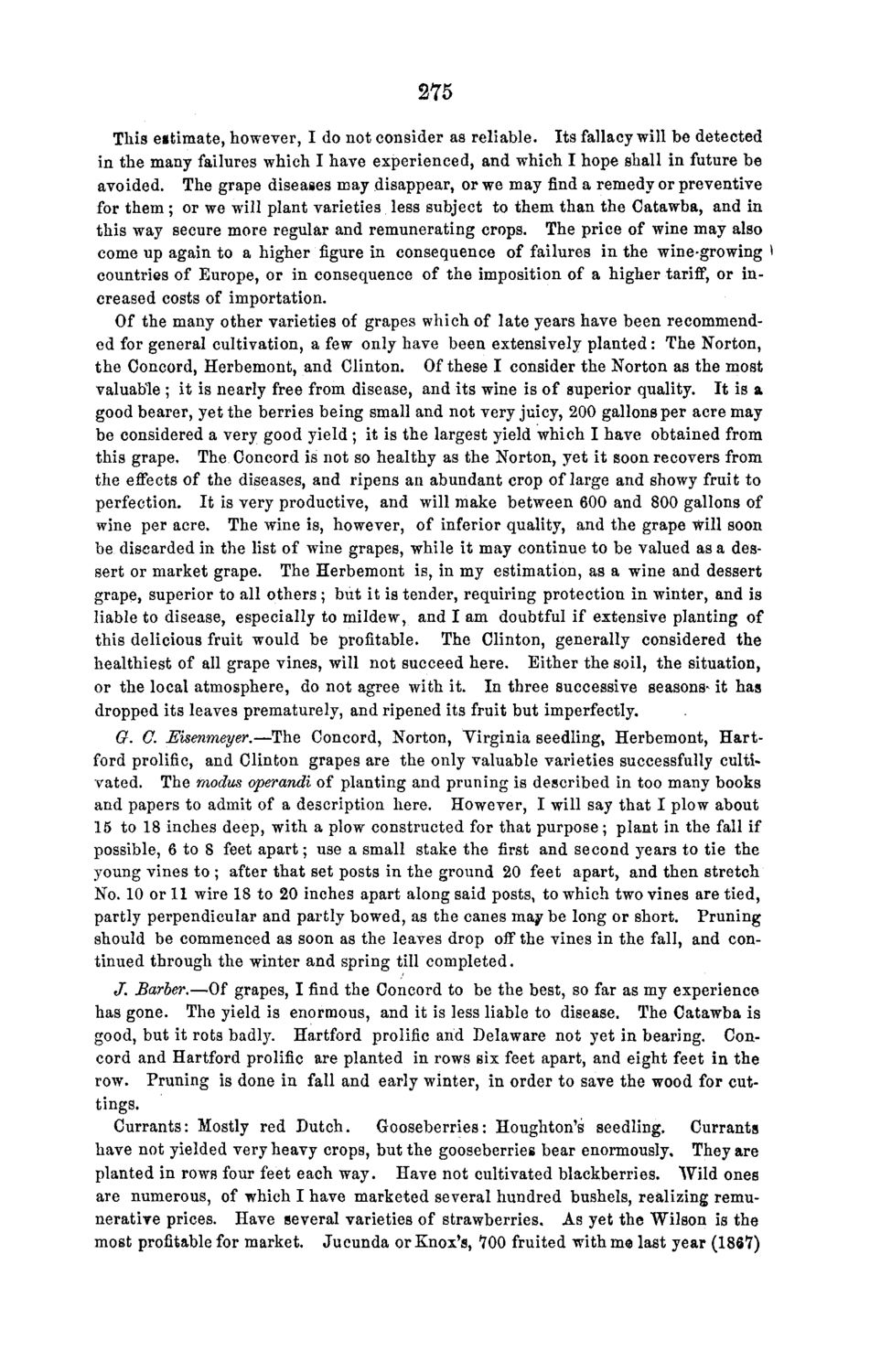| |
| |
Caption: Board of Trustees Minutes - 1868
This is a reduced-resolution page image for fast online browsing.

EXTRACTED TEXT FROM PAGE:
275 This estimate, however, I do not consider as reliable. Its fallacy will be detected in the many failures which I have experienced, and which I hope shall in future be avoided. The grape diseases may disappear, or we may find a remedy or preventive for them ; or we will plant varieties less subject to them than the Catawba, and in this way secure more regular and remunerating crops. The price of wine may also come up again to a higher figure in consequence of failures in the wine-growing I countries of Europe, or in consequence of the imposition of a higher tariff, or increased costs of importation. Of the many other varieties of grapes which of late years have been recommended for general cultivation, a few only have been extensively planted: The Norton, the Concord, Herbemont, and Clinton. Of these I consider the Norton as the most valuable ; it is nearly free from disease, and its wine is of superior quality. It is a good bearer, yet the berries being small and not very juicy, 200 gallons per acre may be considered a very good yield ; it is the largest yield which I have obtained from this grape. The Concord is not so healthy as the Norton, yet it soon recovers from the effects of the diseases, and ripens an abundant crop of large and showy fruit to perfection. It is very productive, and will make between 600 and 800 gallons of wine per acre. The wine is, however, of inferior quality, and the grape will soon be discarded in the list of wine grapes, while it may continue to be valued as a dessert or market grape. The Herbemont is, in my estimation, as a wine and dessert grape, superior to all others; but it is tender, requiring protection in winter, and is liable to disease, especially to mildew, and I am doubtful if extensive planting of this delicious fruit would be profitable. The Clinton, generally considered the healthiest of all grape vines, will not succeed here. Either the soil, the situation, or the local atmosphere, do not agree with it. In three successive seasons- it has dropped its leaves prematurely, and ripened its fruit but imperfectly. G. C. Msenmeyer.—The Concord, Norton, Virginia seedling, Herbemont, Hartford prolific, and Clinton grapes are the only valuable varieties successfully cultivated. The modus operandi of planting and pruning is described in too many books and papers to admit of a description here. However, I will say that I plow about 15 to 18 inches deep, with a plow constructed for that purpose; plant in the fall if possible, 6 to 8 feet apart; use a small stake the first and second years to tie the young vines to ; after that set posts in the ground 20 feet apart, and then stretch No. 10 or 11 wire 18 to 20 inches apart along said posts, to which two vines are tied, partly perpendicular and partly bowed, as the canes may be long or short. Pruning should be commenced as soon as the leaves drop off the vines in the fall, and continued through the winter and spring till completed. J. Barber.—Of grapes, I find the Concord to be the best, so far as my experience has gone. The yield is enormous, and it is less liable to disease. The Catawba is good, but it rots badly. Hartford prolific and Delaware not yet in bearing. Concord and Hartford prolific are planted in rows six feet apart, and eight feet in the row. Pruning is done in fall and early winter, in order to save the wood for cuttings. Currants: Mostly red Dutch. Gooseberries: Houghton's seedling. Currants have not yielded very heavy crops, but the gooseberries bear enormously. They are planted in rows four feet each way. Have not cultivated blackberries. Wild ones are numerous, of which I have marketed several hundred bushels, realizing remunerative prices. Have several varieties of strawberries. As yet the Wilson is the most profitable for market. Jucunda or Knox's, *700 fruited with me last year (1867)
| |